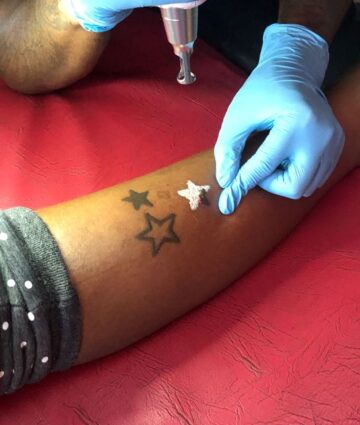Factors that Influence Laser Tattoo Removal
Welcome to Rebel Inks Tattoo Removal and Piercings Parlour, where we embark on an exploratory journey into the mesmerizing world of laser tattoo removal. Beyond the enchanting allure of body art, we shall delve into the fascinating artistry and cutting-edge science that contribute to the successful eradication of tattoos through lasers.
In a world where self-expression through body art has become increasingly popular, tattoos have emerged as captivating symbols of personal identity and creativity. However, as the sands of time shift and life’s circumstances change, tattoos that once held profound meaning may lose their relevance or significance. This evolution of perspectives has fueled the surge in demand for laser tattoo removal, an innovative process that has transformed the tattoo industry and granted individuals a chance to rewrite their narratives.
As every tattoo tells a unique story, its removal presents an equally distinctive adventure. While tattoos may be permanent by nature, laser technology has offered a transformative solution to bid farewell to inked memories. However, achieving optimal results involves an intricate interplay of numerous factors, each playing its crucial role in the journey to tattoo-free skin.

Schedule Appointment
Factors that Influence How Long it will take to Remove a Tattoo
Tattoo Size and Complexity
The size and complexity of a tattoo play a significant role in determining how long it will take to remove the tattoo completely through laser treatments. Larger tattoos often require more sessions to break down the ink particles effectively, while complex designs with multiple colors may necessitate specific laser wavelengths for complete eradication. However, several factors come into play:
- Surface Area: Larger tattoos naturally cover more skin surface, which means there is more ink to be broken down and eliminated. As a result, larger tattoos usually require more laser sessions compared to smaller ones. The process of laser tattoo removal is performed gradually, with sessions spaced several weeks apart to allow the skin time to heal. The larger the tattoo, the more sessions will likely be needed, extending the overall duration of the removal process.
- Ink Density: The complexity of a tattoo refers to its level of intricacy and the amount of ink used in the design. Tattoos with intricate patterns or solid, dense areas of ink may require additional treatment sessions. The laser targets the ink particles, breaking them down into smaller fragments that the body’s immune system can flush out. In complex tattoos, the laser must be applied precisely to target all areas effectively, requiring more time and sessions for complete removal.
- Color Variations: Tattoos with multiple colors can be more challenging to remove than those with a single color. Different ink colors absorb light at various wavelengths, necessitating the use of specific laser types to target each color effectively. For multi-colored tattoos, additional laser sessions or specialized lasers, such as Q-switched lasers, may be required to treat each color separately, extending the overall duration of the removal process.
- Depth of Ink: The depth at which the ink is placed within the skin layers can influence the removal process. Deeper ink deposits may require more laser energy to reach and break down the pigments effectively. Additionally, deeper ink may take longer for the body to eliminate after each treatment, prolonging the overall time required for complete removal.
- Skin’s Healing Capacity: Each person’s body responds differently to laser treatments, and the healing process can vary from individual to individual. Factors such as age, overall health, and lifestyle choices can impact the body’s ability to clear the fragmented ink particles. The efficiency of the body’s immune response influences the rate at which the tattoo fades between sessions.
- Pigment Type: Some tattoo pigments are more stubborn and resistant to laser treatments than others. Black ink, for example, tends to respond well to most lasers, while green and blue pigments can be more challenging to remove. A tattoo with difficult-to-treat pigments may require additional sessions and potentially a longer timeframe to achieve desired results.
Age of the Tattoo
The age of a tattoo plays a vital role in the removal process. Older tattoos are generally easier to remove as they may have faded over time, allowing the laser to target a more distinguishable contrast between the ink and the surrounding skin. Generally, several factors contribute to this phenomenon:
- Fading and Degradation: Over time, the pigments in a tattoo can naturally degrade due to exposure to sunlight, the body’s immune response, and the skin’s aging process. As a result, older tattoos may have already undergone some degree of fading, making the ink particles more susceptible to laser treatment. Faded tattoos tend to have a higher contrast between the ink and the surrounding skin, making it easier for the laser to target and break down the pigments effectively.
- Settling of Pigments: In the weeks and months following the application of a new tattoo, the ink particles may continue to settle into the deeper layers of the skin. Tattoos that have settled over a long period may have a more stable distribution of ink, which can aid in the targeting of the pigments during laser removal. In contrast, newer tattoos may have ink that is more dispersed and may require more laser sessions to achieve complete clearance.
- Ink Composition: Tattoo ink formulations have evolved over the years, and older tattoos might have been made with ink compositions that are less resistant to laser treatments. Newer tattoos may use more advanced pigments, which could be more challenging to break down completely. However, advancements in laser technology have also been made to address modern tattoo inks effectively.
- Skin Changes: The skin undergoes various changes as it ages, and these changes can impact the tattoo removal process. For instance, older skin may have reduced collagen and elastin, which could make it more sensitive to laser treatments. On the other hand, older skin might heal more efficiently between laser sessions, allowing for more frequent treatments.
- Layering and Cover-Ups: Some older tattoos might have been layered over or covered up with new tattoos, adding complexity to the removal process. Multiple layers of ink may require additional laser sessions, especially if different ink colors and types are involved.
Laser Technology and Expertise
Laser technology and the expertise of the practitioner are critical factors that can significantly influence the duration and effectiveness of tattoo removal. Both aspects play a crucial role in achieving the best possible results and ensuring the safety and comfort of the patient during the process:
- Laser Technology: The type and quality of the laser used for tattoo removal are paramount. Different tattoo pigments respond to specific laser wavelengths, so having access to a versatile laser system with multiple wavelengths can enhance the efficacy of the treatment. For instance, Q-switched lasers are commonly used for tattoo removal due to their ability to deliver high-energy, short pulses that effectively target and break down tattoo pigments while minimizing damage to surrounding tissues.
- Wavelength Selection: The right choice of laser wavelength is vital for successful tattoo removal, especially in the case of tattoos with multiple colors. A skilled practitioner will determine the ideal combination of laser wavelengths to target various pigment types, ensuring thorough and consistent removal. Using the wrong wavelength can result in inadequate removal, increased sessions, and potential complications.
- Laser Power and Energy Levels: Adjusting the laser’s power and energy levels requires precision and expertise. An experienced practitioner will calibrate the laser settings based on the tattoo’s size, color, and depth to deliver the most effective treatment without causing unnecessary discomfort or skin damage.
- Spot Size and Pulse Duration: The size of the laser’s spot and the pulse duration also impact the treatment’s effectiveness. Larger spot sizes allow for quicker coverage of the tattoo area, while shorter pulse durations are better suited for breaking down tattoo pigments efficiently. A skilled practitioner knows how to optimize these parameters to suit each patient’s unique tattoo characteristics.
- Expertise and Training: The experience and training of the laser technician performing the procedure are crucial. At Rebel Inks Tattoo and Piercings Parlour we have a deep understanding of tattoo removal techniques, potential complications, and how to minimize risks. Our expertise ensures that each treatment is tailored to the your specific needs, optimizing the number of sessions required and improving the overall outcome.
- Assessment and Treatment Plan: At Rebel Inks Tattoo Removal and Piercings Parlour we conduct a thorough evaluation of the tattoo, considering factors like size, color, location, and skin type. Based on this assessment, we will create a personalized treatment plan that outlines the number of sessions needed, the expected duration of treatment, and the estimated results.
- Post-Treatment Care and Monitoring: Proper aftercare is essential for effective tattoo removal. At Rebel Inks Tattoo Removal and Piercings Parlour we will provide you comprehensive instructions on how to care for the treated area between sessions to promote healing and minimize the risk of complications. Additionally, we will monitor the progress throughout the removal process, making any necessary adjustments to the treatment plan for optimal results.
Session Intervals
Session intervals play a crucial role in determining how long it will take to remove a tattoo through laser treatments. The timing between each laser session is carefully planned to allow the skin to heal and the body’s immune system to flush out fragmented ink particles. The optimal session intervals ensure both the safety and effectiveness of the tattoo removal process:
- Healing Time: Laser tattoo removal involves the use of high-intensity light beams to break down tattoo pigments within the skin. This process creates tiny wounds in the treated area. Allowing sufficient time between sessions allows the skin to heal and reduces the risk of complications, such as scarring or skin damage. Common session intervals range from 4 to 8 weeks, depending on the size and complexity of the tattoo, as well as the individual’s healing capacity.
- Immune Response: The body’s immune system plays a critical role in removing fragmented ink particles after each laser treatment. Giving the immune system enough time to process the ink and flush it out of the body is essential for the gradual fading of the tattoo between sessions. Rushing the process with overly short intervals may hinder the immune response and reduce the effectiveness of subsequent treatments.
- Ink Clearance: Tattoo removal is not an instantaneous process; it occurs gradually over a series of sessions. The body takes time to eliminate the broken-down ink particles, and the extent of clearance between sessions may vary from person to person. Proper session intervals ensure that the body has enough time to remove as much ink as possible before the next treatment.
- Skin Tolerance: The skin needs time to recover and regenerate after each laser session. Shorter intervals between treatments may not allow the skin to fully recover, leading to increased discomfort and potential adverse effects. Longer intervals strike a balance between promoting skin healing and allowing for steady progress in tattoo removal.
- Optimal Results: Following the recommended session intervals ensures that each laser treatment is performed at the ideal time for maximum effectiveness. Regular monitoring by the laser technician or dermatologist helps track progress and make any necessary adjustments to the treatment plan.
- Minimizing Complications: Adhering to proper session intervals reduces the risk of complications associated with laser tattoo removal. These intervals give the skin time to recover, minimizing the likelihood of adverse reactions and improving overall patient satisfaction with the process.
Individual Healing Response
The individual healing response is a critical factor that can significantly influence how long it will take to remove a tattoo through laser treatments. Each person’s body reacts uniquely to the laser procedure and the subsequent healing process, which can impact the overall effectiveness and duration of tattoo removal. Several aspects of the individual healing response come into play:
- Immune System Efficiency: The body’s immune system plays a key role in tattoo removal. After each laser session, the immune system works to eliminate the fragmented ink particles from the treated area. A more efficient immune response can lead to faster clearance of the ink and a more rapid fading of the tattoo between sessions.
- Lymphatic System: The lymphatic system is responsible for transporting waste products, including the broken-down tattoo ink, out of the body. The efficiency of the lymphatic system can vary from person to person, influencing how quickly the body can remove the ink particles from the treated area.
- Overall Health and Lifestyle: Factors such as overall health, diet, hydration, and lifestyle choices can impact the body’s healing capacity. Individuals who lead a healthy lifestyle with proper nutrition and hydration may experience more efficient healing, which can contribute to the effectiveness of tattoo removal.
- Age: Younger individuals generally have more robust healing responses compared to older individuals. Therefore, younger patients may experience faster tattoo fading and potentially require fewer sessions to achieve complete removal.
- Skin Type: Different skin types respond differently to laser treatments. While most people experience positive results from tattoo removal, individuals with certain skin conditions or sensitivities may require special care or more spaced-out sessions to avoid adverse effects.
- Previous Scarring: If the skin has a history of scarring, it may respond differently to laser treatments. Scarring can affect the skin’s ability to heal and may influence the number of sessions required for tattoo removal.
- Post-Treatment Care: Following proper aftercare instructions provided by the laser technician or dermatologist is crucial for successful tattoo removal. Individuals who diligently adhere to post-treatment care guidelines may experience smoother healing and better outcomes.
OUR LOCATION
Areas We Serve
NAIROBI
KIAMBU
KAJIADO
MACHAKOS

